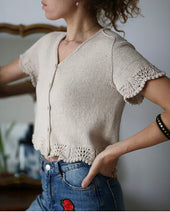How to combine colors in your projects (without fear of making mistakes)
Gemma AdevaHave you ever wanted to start a project with several colors but had no idea how to combine them? You're not alone; it happens to me all the time, and I'm incredibly insecure when it comes to combining colors, despite having been knitting for many years. In fact, for many years I only combined colors that were "safe" for me, or made combinations that I knew would definitely work; I didn't dare take even the slightest risk. Did it look good? Yes, but it was very boring. Needless to say, when I started dyeing, my world expanded dramatically in terms of the way I'd thought about color up until that point. Suddenly, everything was a possibility, and that was great for experimenting and getting out of my comfort zone.
Combining colors that work well together may seem complicated, but I'm going to give you some tips I've learned that will make your life easier when choosing colors for your projects.
The easy way: choose the base color and play with a contrasting color and a neutral
The easiest way to start creating a color combination is to choose a main color (the one you like the most or the one you are sure you want to use) and from that color add a contrasting color and another that is more or less neutral.
Here you can see a pair of palettes using three colors, based on this way of combining colors. The "base" colors are the ones I had already decided to use in the project, because I liked them or thought they were special; the "contrast" colors add a crazy touch of color that makes them stand out, and then I use the "neutrals" to balance the two previous colors.

Use a color wheel
I'm not going to go into color theory here because it would be a bit boring, but if you use a color wheel, you'll quickly understand how colors relate to each other. I have one, and it's incredibly useful for trying out color combinations, getting inspiration for mixes when I need it, etc. These days, you can find them in so many stores and they're very inexpensive, so it's always good to have one at home. In this video, you can see how to use it to combine different balls and skeins; there are color wheel combinations that never fail:
- If you're looking for a softer, more uniform combination, choose analogous colors (those that are next to each other on the color wheel).
- If you want a standout combination, mix complementary colors (colors that are opposite each other on the wheel).
- And to be on the safe side, choose a neutral base plus a striking color.
Some online tools that will also help you a lot when it comes to testing and creating crazy combinations are Adobe Color Wheel and Coolors (both are free and you can see how they work in the video I linked above). I find them very useful, especially Coolors because I can extract colors from an image and use them to tint new colors :)
My favorite combinations
Here are some of my favorite combinations this season in two and three colors, all with skeins you can find in stores. Many of them I wouldn't have dared to make a couple of years ago! For example, the Strawberry Milkshake + Dusk + Lichen combination is the one I used to knit the Fiber Fest Shawl from Westknits :

And don't forget, if you have any doubts about combining colors, the best thing you can do is knit a small sample that includes all the colors you'd like to use, so you can see for yourself if you got it right.



